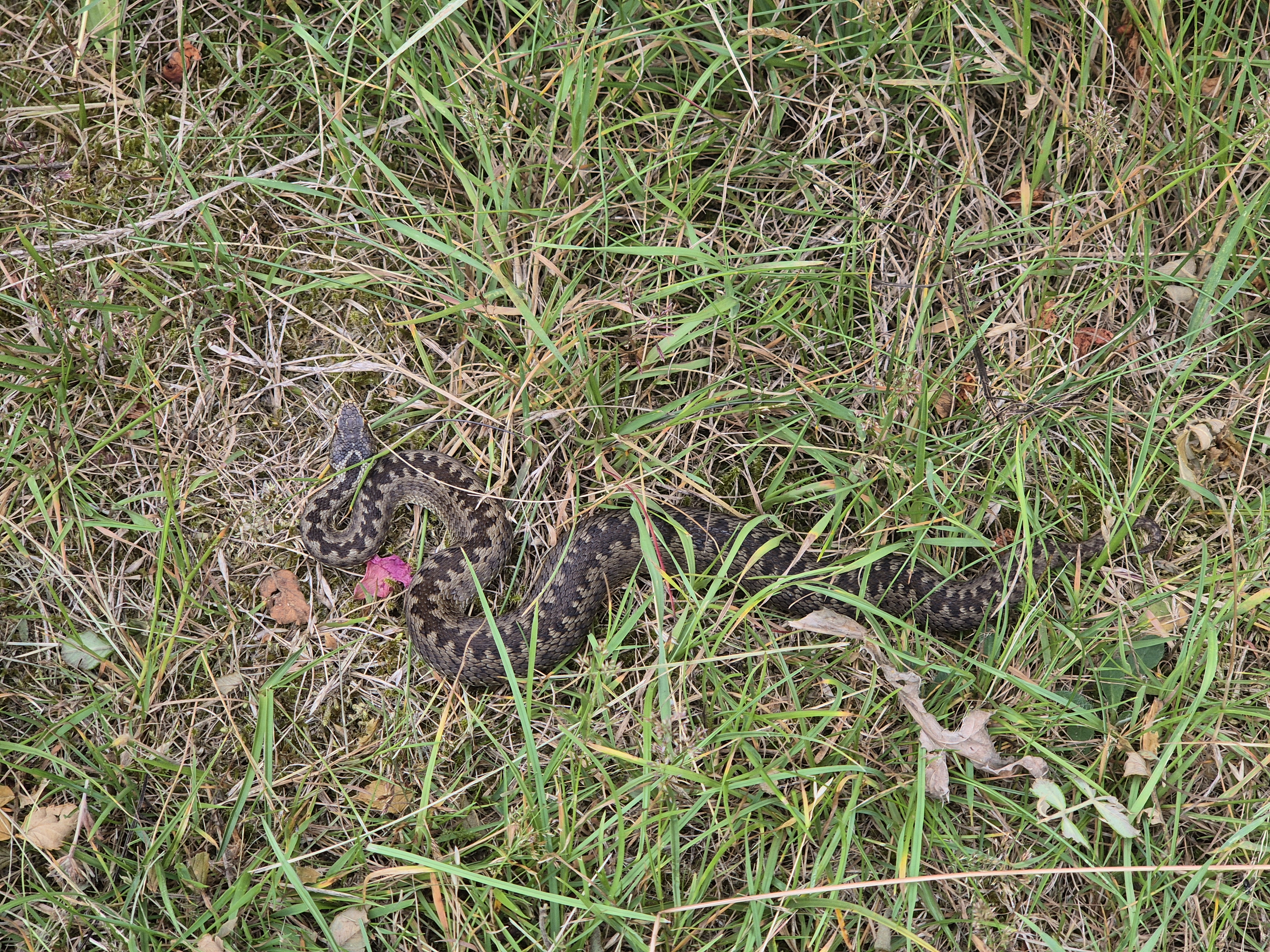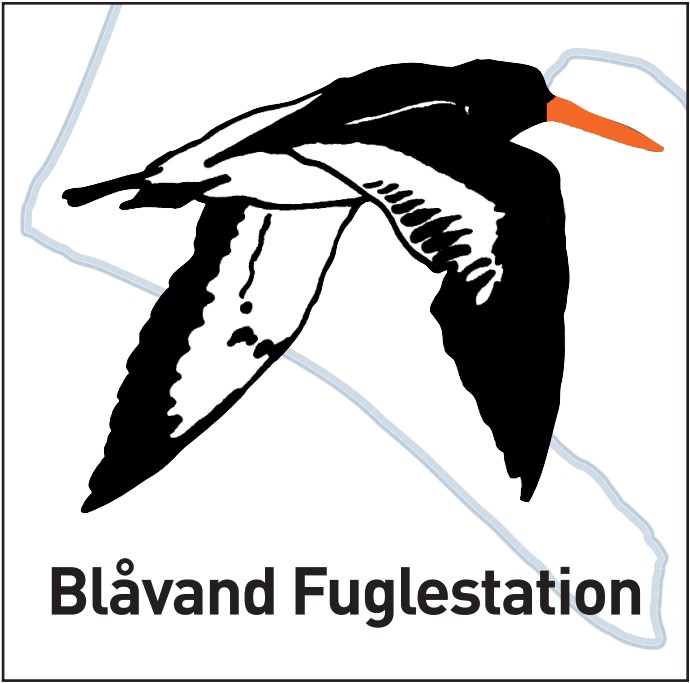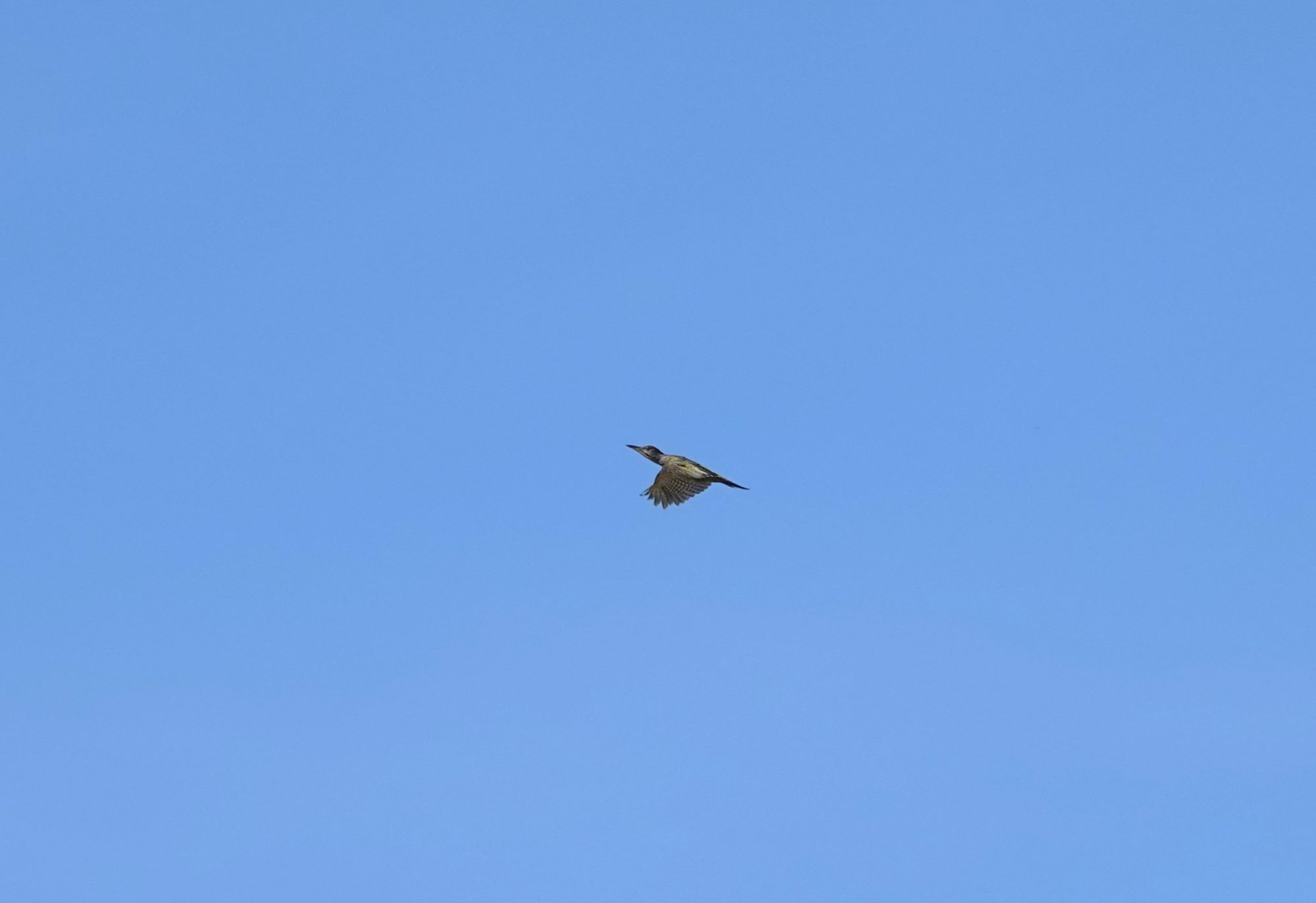Her på Blåvand's blog bringes korte nyheder i dagbogsformat om livet og hændelser på fuglestationen.
Slow but colorful
Morgen observation:
Endnu en dag med NV-vind... og det bliver altså ikke ligefrem sjovere. Det føles lidt, som om jo flere dage i træk vinden ligger i NV, desto mere stædige bliver fuglene – og nægter at trække.
Det gjorde også, at Henrik og jeg igen i dag havde en meget stille dag på obsen. Så stille, at vi efter den første time jokede med, om vi mon overhovedet ville nå 30 vader i dag.
Det gjorde vi dog – vi kom faktisk op på 99 trækkende vader, med højdepunktet værende en fin flok på 5 stenvendere, der kom rigtig godt sammen.
Men endnu en gang var det de rastende fugle, der leverede størstedelen af underholdningen. Vi havde 5 kaspiske måger og 1 ride på stranden i dag – og det er jo altid lækkert.
Der var også masser af tid til, at Henrik kunne lære mig lidt mere om de detaljer, der adskiller en kaspisk måge fra en sølvmåge. Og med en flot 3K kaspisk måge som model kunne jeg faktisk begynde at se nogle af de små detaljer – og hvor forskellige de to arter egentlig er, når man dykker ordentligt ned i dem.
Efter den meget stille morgenobs gik vi tilbage til stationen, og jeg fik data lagt ind i DOFbasen.
Efter lidt afslapning på stationen trak det lidt i mig for at få en ny art på listen, så jeg besluttede at køre efter Lunden på Nordfyn. Og når jeg nu var ude, svingede jeg også forbi den rødhovedet tornskade ved Haderslev. Det gav to nye krydser på listen – virkelig dejligt efter nogle sløve dage her i Blåvand.
THK
Ringmærkning:
Wind has been picking up over the last few days and will be tomorrow as well, so we expect fewer and fewer birds. Our surprise was big then, when, in the first net check of the day we had not only one or two but six birds in total! Of course, we got our hopes up (too) high. Naturally the day couldn’t be expected to continue the same way, but we did not get bored until 8am, always having a bird or two to process. Compared to yesterday we had one less recapture today, but with only 12 birds caught we tallied 10 species today, which is quite impressive even if none of the species were exciting as such. We will not complain.
For the most part, today’s captures were local birds still, mainly young ones who still need to learn to avoid the nets. But adding to yesterday’s two blackcaps, being the first for the season and although probably not “real” migrants yet, at least moving in some way, we caught another wone today. But, even better, we caught the first common redstart of the season which does not breed in the near surroundings do it could already be counted as a migrant. Meaning more will come soon…
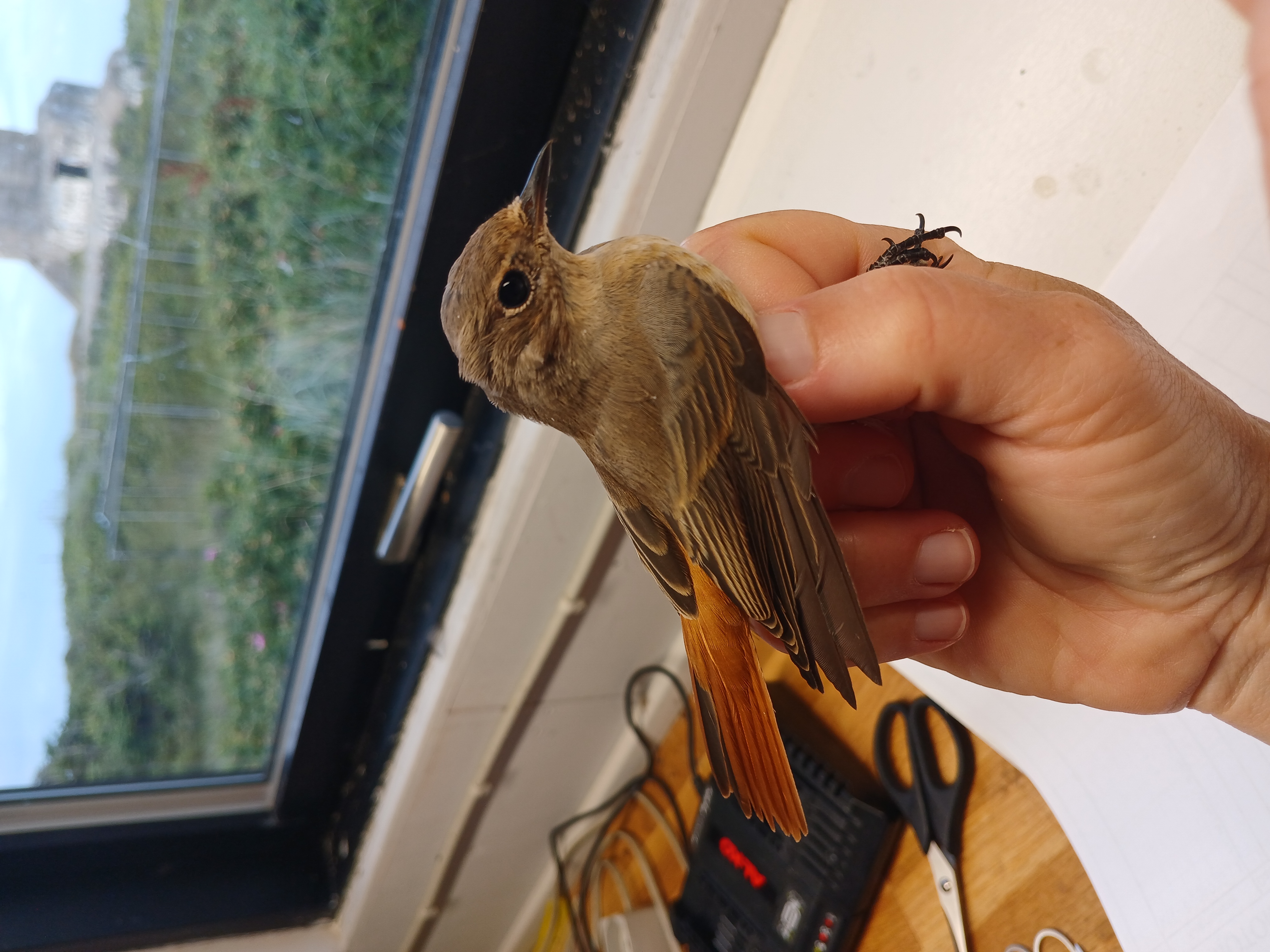
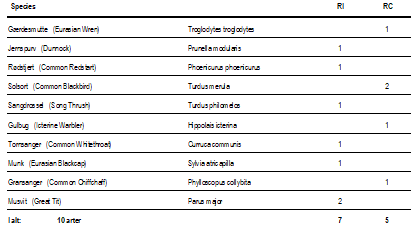
In the afternoon, Jospeh's family left. Joseph will leave tomorrow morning, which means we will be only to people staying at the station for now until the next volunteer observer arrives.
MH
Folk på stationen: Estelle Cumin, Henrik Böhmer, Thomas Kristensen, Martina Hillbrand og Joseph Stephan
The sausage of death
Morgen observation:
Vinden startede i vest, hvilket kan være fint for nogle arter af vader, men den skiftede desværre utroligt hurtigt til mere nordvestlig – og det er virkelig ikke ideelt for vadefugletræk.
Så det blev endnu en sløv dag, hvor rastefuglene desværre igen blev det eneste, vi rigtigt kunne glæde os over. Til gengæld var det et flot udvalg: fjordterner, en del hav- og splitterner, hele fire kaspiske måger, den samme dværgmåge, som efterhånden har været her længe – og i dag også en rastende 2k ride. Så det var bestemt fint!
Men vi vil jo gerne, at trækket – og især vadertrækket – også begynder at tage overskrifterne og stå for underholdningen på obsen.
Hvis vi alligevel skal se lidt på det, der rent faktisk trak, så havde vi:
- 87 strandskader
- 72 islandske ryler
- 51 sandløbere
- 6 almindelige ryler
- 1 lille kobbersneppe
- 9 småspover
- 1 stenvender
- og 4 hvidklirer, hvoraf to fløj lidt rundt og smårastede på stranden
Det var da meget fint – men med kun 231 vader i alt kan vi bestemt ikke klappe i hænderne. Hvis ikke antallet snart begynder at stige, kan det her ende med at blive et kritisk dårligt vadefugletræksår.
For perioden 20. juli til 20. august burde vi se langt højere tal, end hvad vi overhovedet kan forestille os at nå lige nu.
Men – man ved aldrig. Alt kan ske under trækket, og måske får vi en eller flere af de dage, hvor det vælter ind med over 3.000 vader. Lige nu siger prognoserne desværre NV-vind det næste lange stykke tid – og det lyder ikke lovende, hvis vi skal nå vores mål.
THK
Ringmærkning:
Not much to write about today. It was a little colder, with a wind blowing from the northwest. It wasn't the most exciting day for Freya's departure and Martina's arrival! Indeed we had less luck than yesterday, but we still caught two species that we hadn't caught yet this week: two Eurasian Blackcap and an Eurasian Tree Sparrow. It was kind of the "sausage of death"; indeed, I learned that this expression is a literal translation of a Danish idiom meaning something is boring. In French we say "to be bored like a dead rat". Strange linguistic expressions of unknown origin. But well, tomorrow is another day!
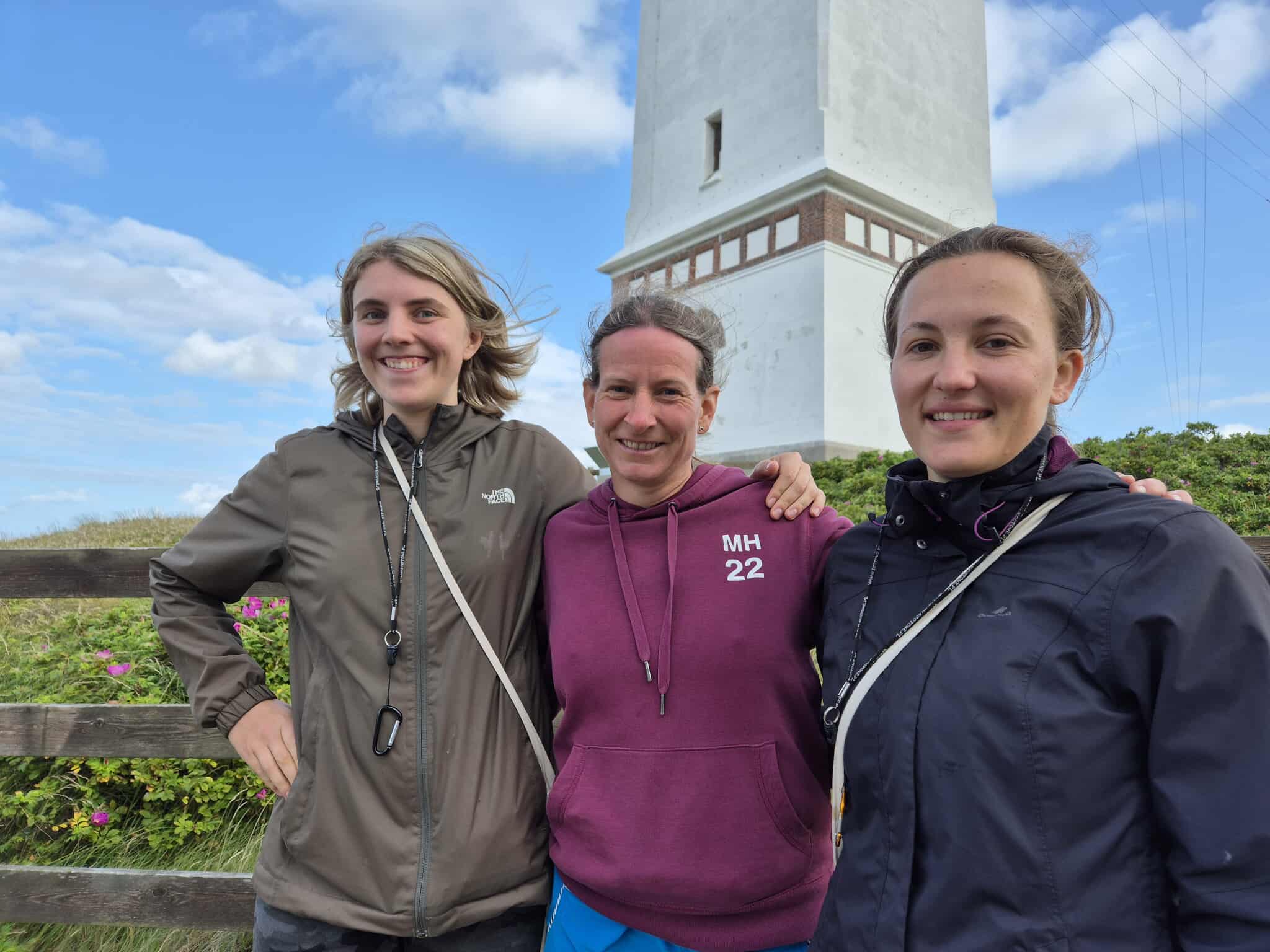
Dark circles under our eyes but smiling faces :D
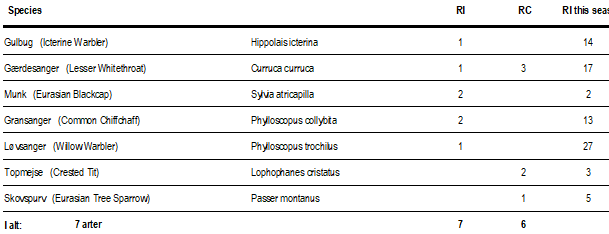
EC
Folk på stationen: Freya G. Mørup-Petersen, Estelle Cumin, Henrik Böhmer, Thomas Kristensen, Martina Hillbrand og Joseph Stephan
Roller coaster morning!
Morgen observation:
Endelig var vinden kommet væk fra de nordlige retninger og lå i dag i ren vest. Det var en noget blæsende dag på obsen, og jeg håbede, at der – selvom det ikke er det bedste tidspunkt for havfugle – alligevel kunne komme noget spændende ind i den forholdsvis kraftige vestenvind.
Om ikke andet, så måske den almindelige skråpe, jeg går og venter på, ville dukke op i dag. Det er jo en god tid for dem lige nu, så det kunne godt være sket – men nej, ikke i dag.
Til gengæld var der for første gang i flere dage lidt reel bevægelse af vader. Og ikke kun almindelige ryler og strandskader – også en del islandske ryler og en enkelt mega lækker krumnæbbet ryle, der kom trækkende rimeligt langsomt, meget tydeligt og tæt på. Det var helt klart dagens højdepunkt på obsen for mig.
Ud over det var der selvfølgelig også nogle rastefugle, selvom højvandet gjorde, at mange måtte finde andre steder at stå. Over de seneste par dage er antallet af splitterner heldigvis begyndt at ligne noget igen – omkring 100 fugle i dag.
På et tidspunkt havde jeg en tårnfalk, der musede rundt over området og forsøgte adskillige gange at fange noget at spise. Det var hyggeligt at følge med i, og jeg nød, hvor tydeligt man kunne se den – endda i skopet, når den dykkede ned i feltet.
Men det skulle vise sig, at den måde, jeg så den på, var ingenting i forhold til, hvor tæt jeg senere kom på en tårnfalk... Teaser til ringmærkningsdelen.
Ellers mindede obsen meget om de sidste par dage: Næsten samme antal rastefugle, lidt bevægelse af sortænder, en del rastende suler på vandet – og en enkelt almindelig kjove, der kom dejligt tæt på.
Efter jeg i går gennemgik alle de forskellige dragtmønstre og hvordan man aldersbestemmer kjover – samt hvordan man adskiller almindelig kjove fra de andre arter – sammen med Henrik, fik jeg virkelig kigget godt på fuglen i dag. Det er en mega fed følelse at se de ting, man læser om i bøgerne, komme til live ude i felten.
Da jeg kom tilbage til stationen, satte jeg mig i "biblioteket" på fuglestationen og dykkede ned i bøger om havfugle og måger – især dem, jeg håber snart begynder at komme. Jeg læste om, hvordan man kender de mega svære måger fra hinanden, og nu må vi se, om teorien også kan bruges i praksis.
THK
Ringmærkning:
What a morning! Freya and I went through a lot of emotions today.
The early morning was quite windy, and the wind was pretty much the only thing we were capturing. But things quickly heated up when we got our revenge on a pigeon.

Indeed, yesterday, if you are loyal readers, you know that two pigeons got away from us. But this time today, we managed to catch one (a young one).
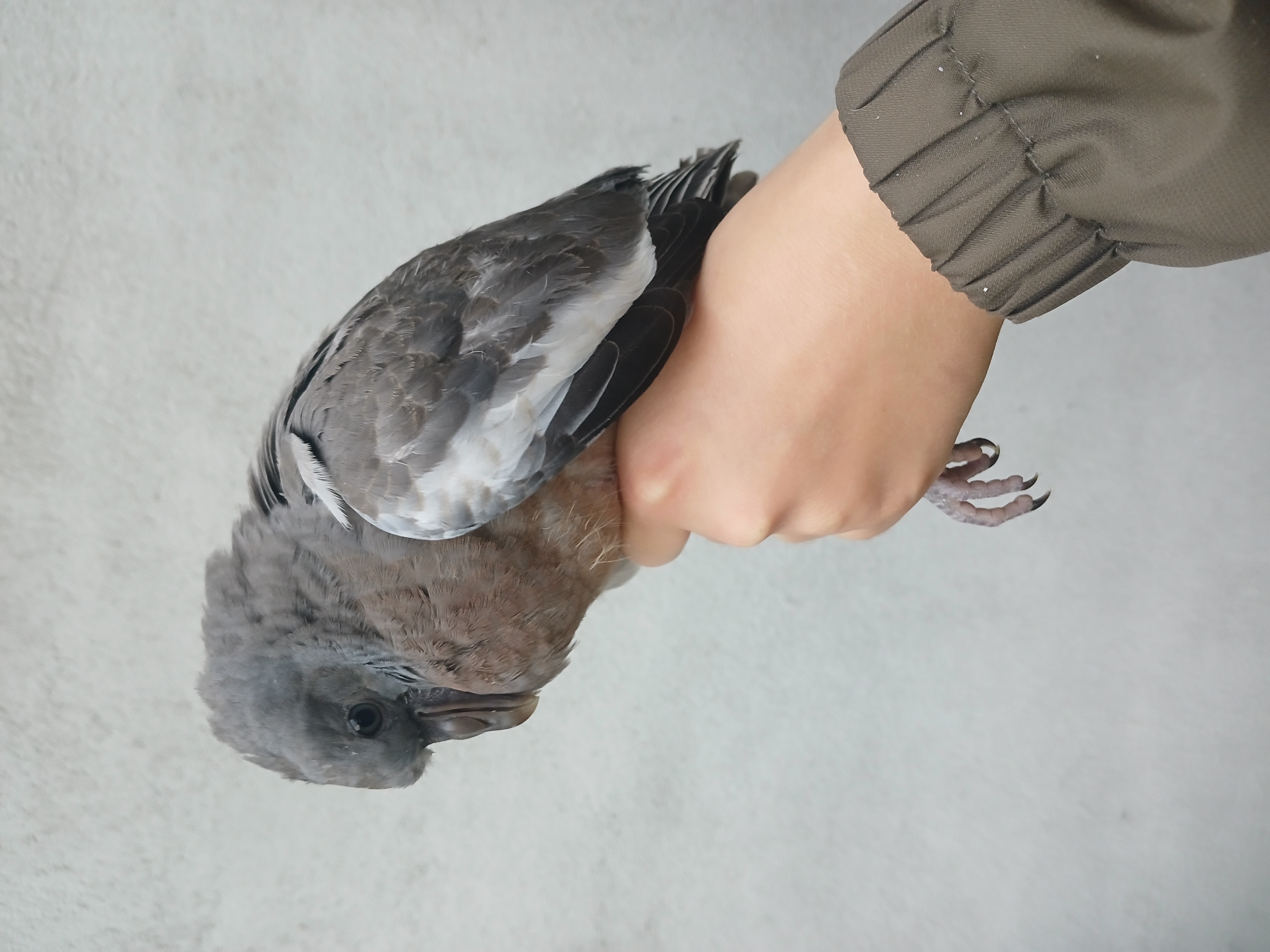
Don't fool me twice
This happy capture was followed by a loooong period of boredom as the rounds followed one another, each one emptier than the last.
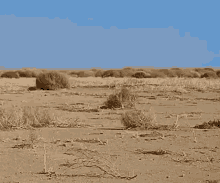
But new twist! The 8:30 round seemed completely empty, but in the lighthouse garden, we first caught four passerines in a row, which made us very happy, but we had no idea what awaited us in the last two nets of the krat...
A Kestrel (a young female; the third mention for the station) and a Green Woodpecker (a young male; the fifth mention for the station)!
We were super happy and excited. It was very interesting to study the sex and age criteria for these two rarely captured species. A little photo shoot was in order.
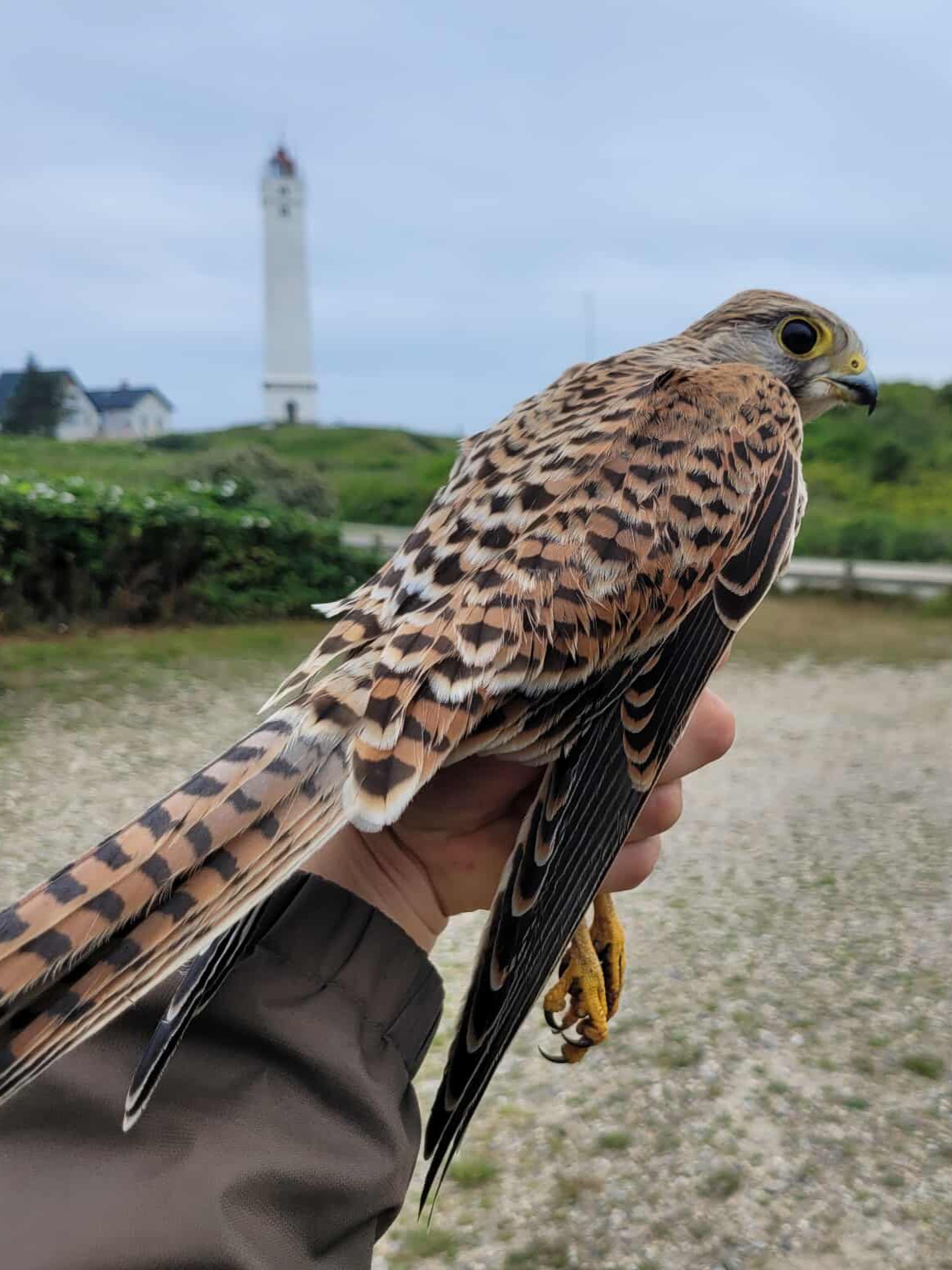
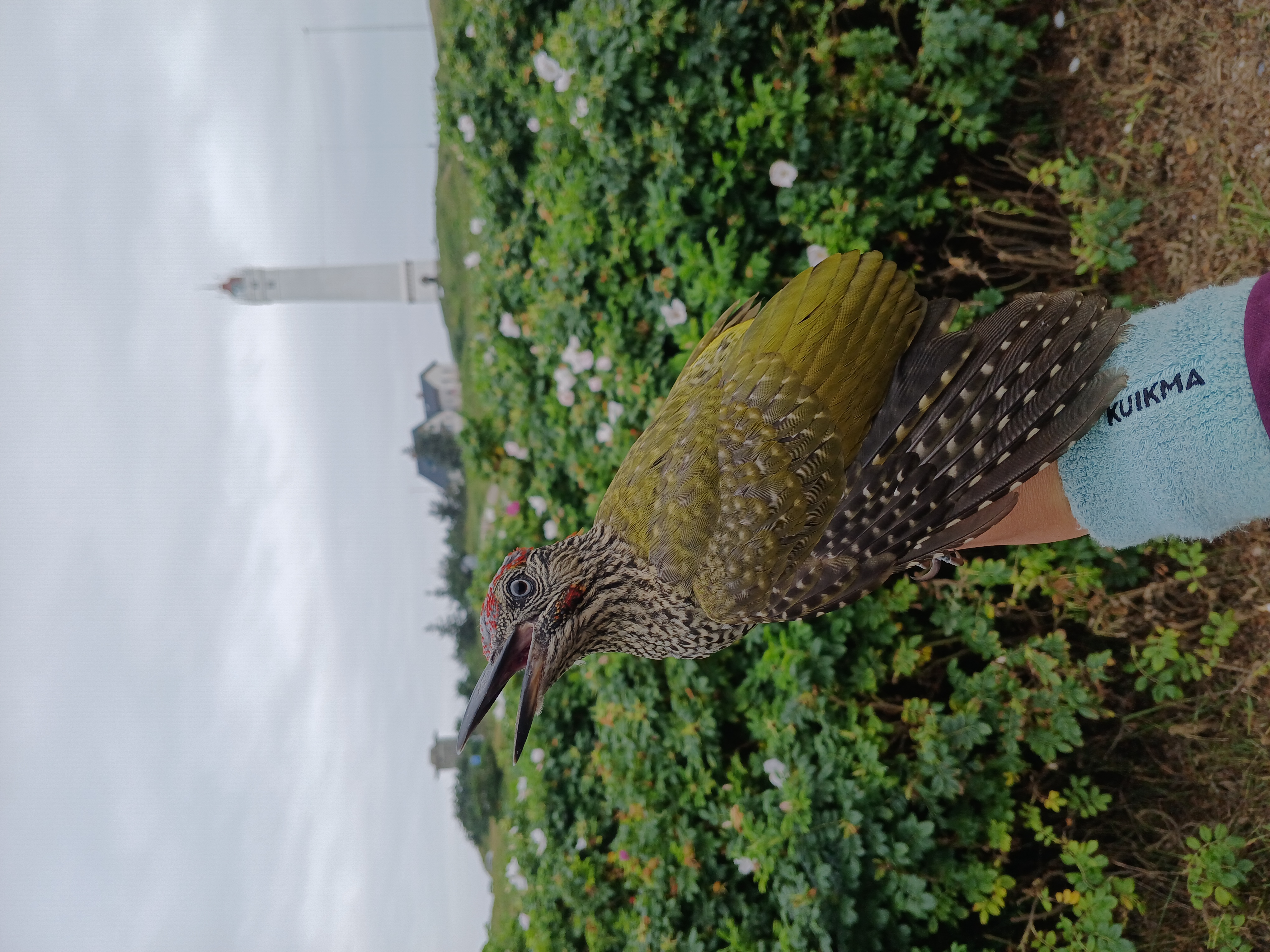
The joys of Blåvand!
So this morning ended beautifully. We then caught a pretty variety of other species, which we were able to show to our weekend guests.
Fun fact: we also caught an adult Yellowhammer that had been ringed as a juvenile in 2019!
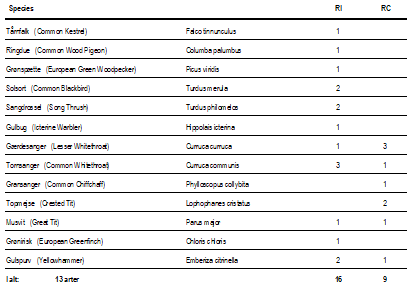
EC
Folk på stationen: Freya G. Mørup-Petersen, Estelle Cumin, Thomas Kristensen, Joseph Stephan og Josephs bedsteforældre
Nordvestenvind er dræbervind
Morgen observation:
Vinden var gået i NV i dag, og det gjorde da, at der skete lidt mere end i går, hvor den stod i direkte nord. Når det er sagt, var det bestemt stadig ikke en god trækdag.
Der var meget lidt bevægelse over havet, og de tre timer føltes lidt lange for Henrik og mig. Heldigvis var der lidt lækre ting blandt rastefuglene i dag. Vi havde blandt andet en sorthovedet måge, en dværgmåge og flere kaspiske måger i forskellige aldre – så det var faktisk ret fint.
Derudover havde vi også en del almindelige kjover i dag, hvor flere kom rigtig tæt på, så alle detaljer kunne ses – det var virkelig lækkert og gjorde dagen meget bedre.
Og selvom selve trækket var ret svagt, kom vi alligevel op på syv forskellige arter af vader i dag – dog kun meget få af hver slags.
THK
Ringmærkning:
I dag var vinden ret kraftig fra nordvest, da vi stod op og den ville ikke aftage ret meget, så vores forhåbninger for dagen var ikke frygtelig høje. Dog startede første runde med en Sangdrossel og en Solsort i Stationshaven, hvilket gav os en svag optimisme. Men det viste sig hurtigt, at vores første forventning holdt stik, for runde efter runde gik vi til tomme net. Der sad dog med to runders mellemrum en ung Ringdue i et af nettene, først i Fyrhaven og derefter i Krattet, men begge gange nåede den at smutte fra os. Modsat de andre dage, hvor vi besluttede os for at holde nettene åbne til efter standard, var Estelle og jeg enige om, at vi lukkede når standard sluttede - krattene var ret tavse og nettene tomme.
Da klokken var 9 ringede Bent til os og sagde, at han kom forbi om lidt og havde sit barnebarn på besøg, der gerne ville se en fugl eller to. Jeg sagde at vi med den dag vi havde haft, ikke kunne love det store, men ville gøre vores bedste. Da Bent kom begyndte vi at lukke nettene med hans hjælp, hvilket gik ret hurtigt, men nettene var desværre tomme i både Stationshaven og Fyrhaven. Heldigvis havde vi alligevel lidt held, for i Krattet sad der en Skovpiber i det ene net. Den fik en ring på og blev vist frem til stor glæde, hvorefter den fik sin frihed igen.
Jeg spurgte Bent ind til, hvad han mente om vejrudsigten, da vejret i morgen ser ud til at blive meget ligesom det i dag, men med vind fra vest i stedet for nordvest. Bent sagde, at det godt kunne blive lidt bedre i morgen, da 'nordvestenvind er dræbervind' herude på Hukket. Så vi håber på en lidt mere begivelhedsrigdag i morgen i forhold til i dag. Om eftermiddagen kom Joseph tilbage og til aften kommer hans bedsteforældre også, som bliver her et par dage.
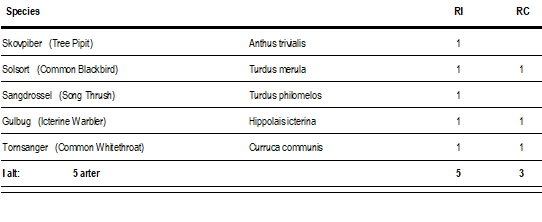
FGMP
Folk på stationen: Freya G. Mørup-Petersen, Estelle Cumin, Henrik Böhmer, Thomas Kristensen og Joseph Stephan
Good variety of species despite nothern wind
Morgen observation:
Det var endnu en dag med meget lidt vind på obsen, men da vinden var i nord i dag, var det måske faktisk en god ting – for der er ikke særligt meget, der trækker i nordenvind på denne tid af året. Hvis vinden var så rolig, at fuglene bare ignorerede den, kunne det måske blive en fin dag med lidt vader og andet godt.
Men nej. Selvom vinden kun kom med omkring 2 m/s og næsten ikke kunne mærkes, nægtede fuglene at ignorere, at den stadig kom fra nord – og derfor valgte de fleste ganske enkelt ikke at trække i dag.
Det blev derfor en meget stille dag. Alle rastefuglene blev tjekket grundigt og flere gange gennem de tre timers obs, bare for at have lidt at lave. Men selv her var der ikke noget særligt at finde.
Jeg havde i dag 54 vadefugle fordelt på fem arter – selvfølgelig med hovedparten som almindelige ryler og strandskader. Udover det var der lidt bevægelse af sortænder, og i dag lå der også en del rastende sortænder lige ud for kysten.
Dagens højdepunkt på trækket var nok en fløjlsand, der trak forbi rigtig fint og tæt på – eller de fem grågæs, der kom flot trækkende mod syd. Der er bare noget særligt over at se gæs trække ved Blåvand. Store fugle, der ofte flyver i en flot formation – det glæder jeg mig virkelig til at se mere af, når der snart begynder at komme store flokke af forskellige gæs forbi. I dag måtte jeg nøjes med fem grågæs, men det var stadig fedt.
Når der ikke skete noget over havet – hvilket var det meste af dagen – nød jeg at kigge på alle ternerne, især de rigtig fine unge splitterner. Jeg synes, de ser super seje ud – både når de flyver rundt, og når de bare står på stranden og javer rundt med de andre terner.
I morgen ser det ud til, at der kommer rimeligt kraftig vind fra NV – så forhåbentlig kan det noget mere end i dag. Måske kan jeg endda være heldig, at det blæser en almindelig skråpe ind til mig – en art jeg virkelig håber at få at se. Så jeg krydser fingre for en god obs i morgen!
THK
Ringmærkning:
This morning, the first round to check the nets didn't look promising. Freya and I indeed thought we would come back empty-handed from our first round in the garden. Despite favorable weather conditions, we didn't hear much activity. But it turned out that we had one pleasant surprise after another, as we captured a good variety of species. Among them were a tree pipit, a bullfinch, as well as a yellowhammer (which I really had been hoping to catch!).
We also had a treecreeper, which required a little investigation to determine whether it was a Eurasian treecreeper or a Short-toad treecreeper. After careful study, it was a Short-toad treecreeper. It was very interesting to study all the different criteria.
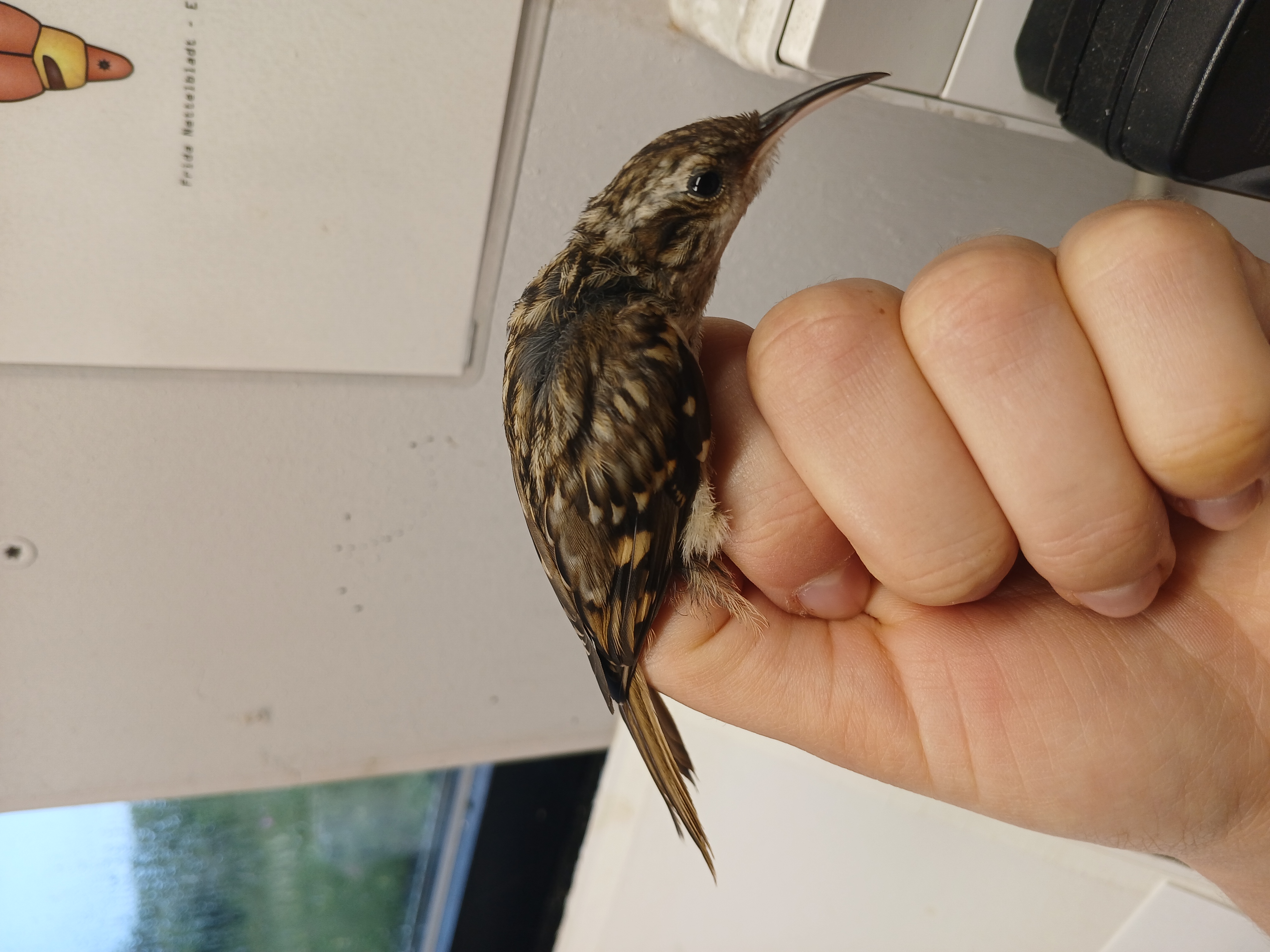
Lastly, cute moment alert of the day: we caught two young linnets that just fledged, as well as a shiny male, which may have been a little family. The mother must have been wondering where they had gone, but we promise we released them together shortly afterwards, just long enough to take a family photo.
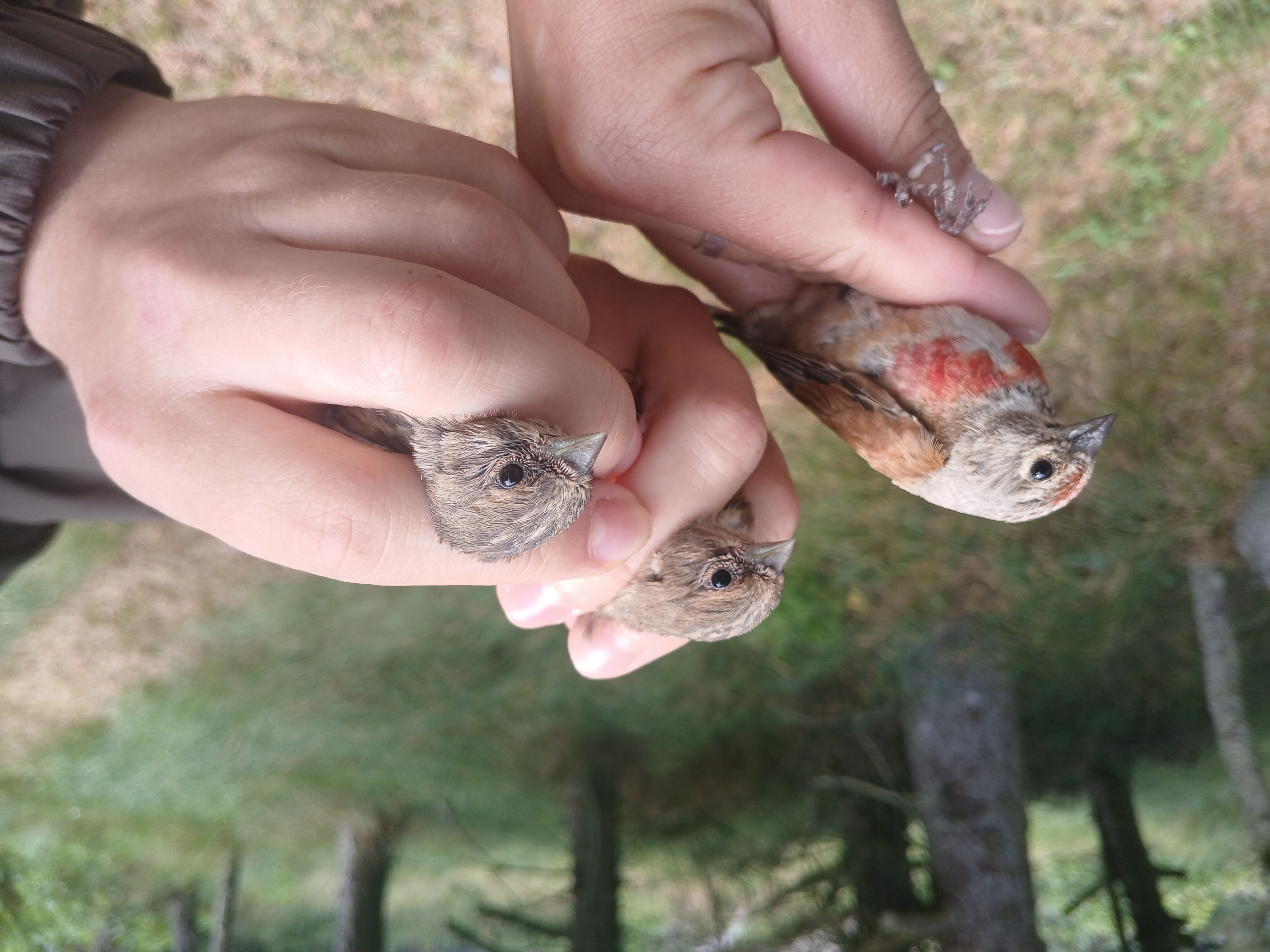
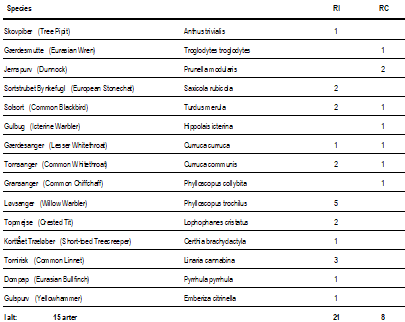
EC
Folk på stationen: Estelle Cumin, Freya Mørup-Petersen og Thomas Kristensen
Baby pigeon!
Morgen observation:
Endnu en utrolig lummer varm dag i Blåvand. I det mindste havde man i dag ikke følelsen af, at det kunne begynde at regne hvert øjeblik det skulle være – som det ellers har været de sidste par dage.
Vinden var taget lidt til og var desværre drejet op i NNV, og når vinden kommer mere nordlig end NV, plejer det sjældent at betyde en god dag på obsen. Henrik og jeg satte os i “hullet” – en af de gode obs-poster, især når det blæser – da vinden lå på omkring 6 m/s. Og da det ikke så ud til at blive en dag, hvor vaderne ville vælte ind, virkede det ikke nødvendigt at bruge vadefuglespottet.
Der var god tid til at hyggesnakke på obsen i dag, for der var langt mellem fuglene. I de første fire intervaller kom der kun få vader og lidt andet over vandet. Da solen rigtig begyndte at bryde igennem, og vinden gik mere i nord i de sidste to intervaller, døde bevægelsen over havet helt ud.
Så det eneste, der bevægede sig, var nogle få sortænder og to toppet skallesluger.
Som skrevet var det ikke nogen imponerende dag for vadefugle, men i løbet af de første fire intervaller kom der:
- 19 strandskader
- 1 småspove
- 1 lille kobbersneppe
- 1 mudderklire
- 1 hvidklire
- 2 stenvendere
- og 5 almindelige ryler
Så ja, det var ret dårligt. Det føltes ikke ligefrem som om, det væltede ind med kandidater til dagens højdepunkt – men hvis vi skal vælge noget, må det være en enkelt ride, der kom trækkende mod nord. Eller at vi i dag havde en del havterner rastende på stranden sammen med fjordternerne.
THK
Ringmærkning:
Efter en dag uden mærkning i går, var det en fryd at stå op til en morgen uden regn på radaren, hvor vi kunne foretage standardmærkning. Estelle og jeg gik i gang med at åbne net og da vi kom tilbage talte vi lidt om, at det kunne være sjovt at få en due i nettet. Selvom duer af og til går i nettene, ryger de nemt ud igen grundet deres størrelse og på trods af at de virker lidt kluntede, er de faktisk ret smarte og gode til at undgå nettene generelt, så det er ikke en så hyppig fangst, som man skulle regne med. Mens vi ventede på, at første runde skulle starte, kunne jeg se en ringdueunge, som jeg har set i haven de sidste par dage, flakse klodset rundt i haven, nok en af dens første rigtige flyveture og tænkte, at den måske kunne gå i nettet. Og det viste sig hurtigt at være rigtigt, da den sad i det første net på første runde. Estelle ringmærkede den og vi tog nogle billeder af dueungen, hvorefer vi lod den flyve videre.
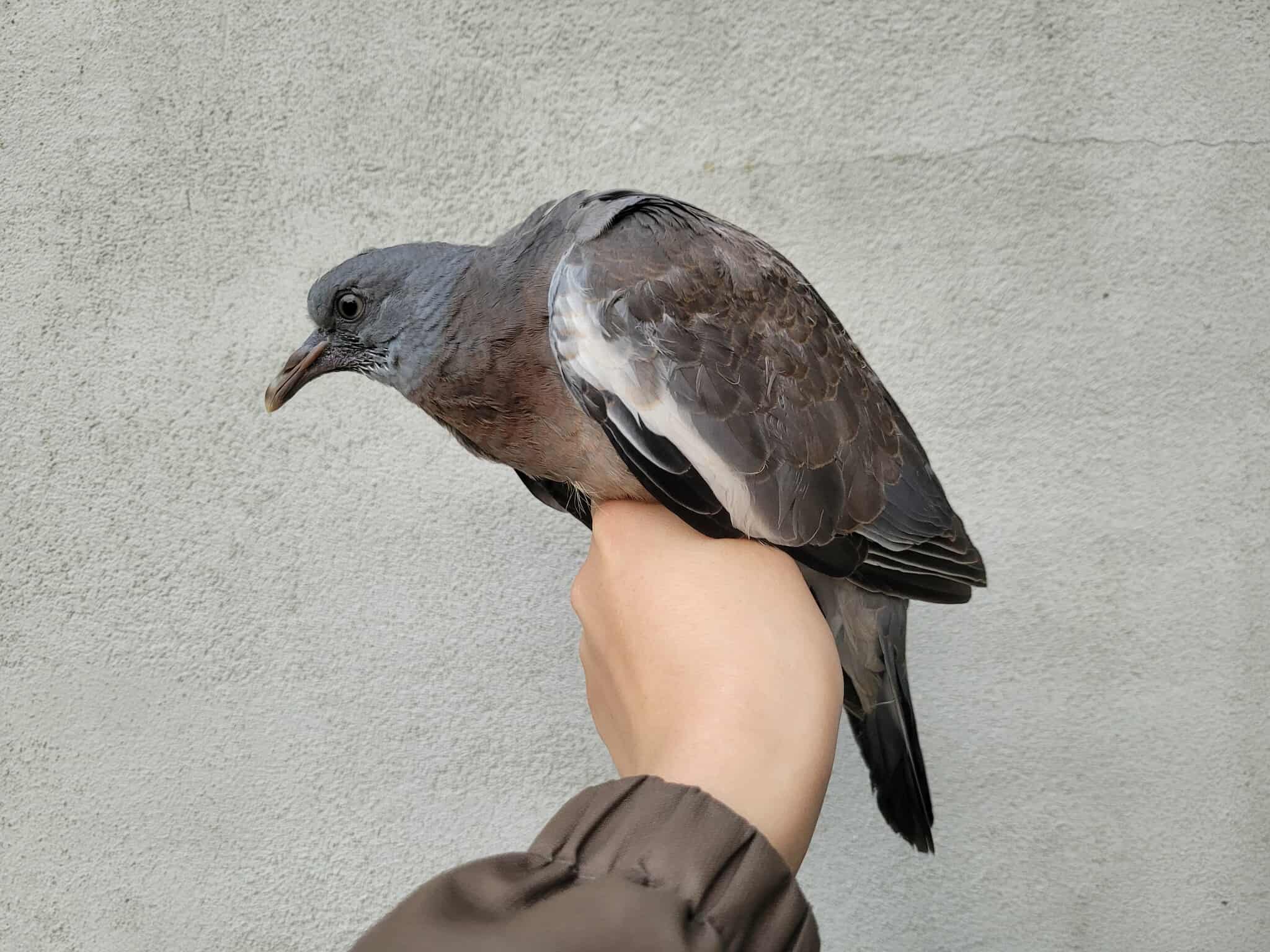
1k Ringdue
Resten af dagen var meget stille, men jeg lod nettene i begge haver stå oppe efter standard, hvor jeg gik runder med jævne mellemrum indtil jeg lukkede ved 16-tiden - der var jeg helt smadret. Det blev heller ikke til så frygtelig mange flere fugle efter standard, men vi kom da op på 15 mærkninger og 8 aflæsninger, hvilket er ganske pænt.
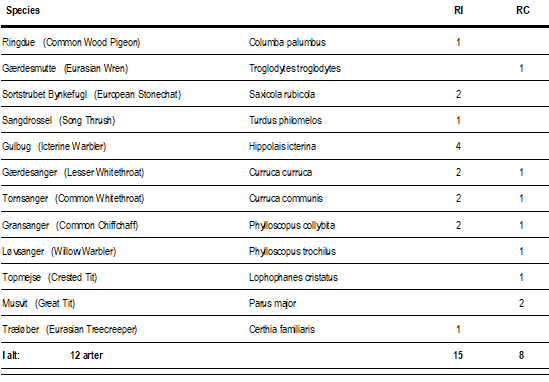
FGMP
Folk på stationen: Estelle Cumin, Freya Mørup-Petersen, Henrik Böhmer og Thomas Kristensen
Våd dag i Blåvand
Morgen observation:
Da jeg kom til Blåvand, småregnede det, og indimellem kom der rimeligt kraftige byger. Jeg kiggede på vejrudsigten, som sagde, at det ville holde tørt fra kl. 6 til 8 – så jeg tænkte, det passede fint med morgenobsen.
Jeg gik ud til obs-spottet, satte mig til rette i småregn og startede obsen kl. 5:15. Men der skete ikke rigtigt noget over vandet. Derfor valgte jeg at lave en rastefugletælling med det samme – noget vi normalt først gør hen mod slutningen af obsen – for at sikre mig, at den var klaret, hvis regnen tog til, og jeg blev nødt til at forlade posten.
Obsen blev bestemt ikke nemmere af, at det hele tiden skiftede mellem småregn og kraftigere byger. Det gjorde både, at det var meget mørkt over vandet, at sigten – som i forvejen var dårlig – blev værre, og at jeg selv blev godt irriteret over hele tiden at skulle pakke paraplyen op og ned.
Efter halvanden times obs, omkring kl. 6:45, begyndte det at regne mere konstant og ret kraftigt. Jeg besluttede derfor, at hvis det ikke blev bedre inden kl. 7:15, ville jeg stoppe der. Det ville stadig give mig de 2 ud af 3 timer, der skal til for, at obsen kan tælle som en standardobs.
Da klokken blev 7:15, regnede det stadig, og der skete stadig stort set intet over havet. Så jeg pakkede sammen og vendte tilbage til stationen for at få skrevet de få data fra obsen ind.
I løbet af obsen kom der fem arter af vader trækkende:
- 1 småspove
- 1 lille kobbersneppe
- 3 islandske ryler
- 56 almindelige ryler
- og 11 strandskader.
Der var et par rimeligt store flokke sortænder – i hvert fald for denne tid på året – men ellers var rastefuglene også i noget lavere antal end de foregående dage.
Dagens højdepunkt for mig blev faktisk ikke en fugl – men at der lå hele 22 gråsæler og rastede på nogle af de fjerneste sandbanker. Det var ret vildt at se, da det normalt mest er spættede sæler, vi ser i store antal her ved Blåvand.
THK
Ringmærkning:
Today, rain and wind decided that the ringing station would not open. Indeed, heavy rain and wind were expected all along the day, and it was confirmed by the weather radar when we woke up at 4am. Freya still opened the nets at around 9am, but the rain was coming, so they were quickly closed again. Nevertheless, it enabled to catch 1 Wren (recapture) and 1 Icterine Warbler.
By the way, rainy day means cleaning day! We took advantage of this bad weather to rest, clean the house, and also cook. So, home-made pizzas and cakes are on the menu for dinner!
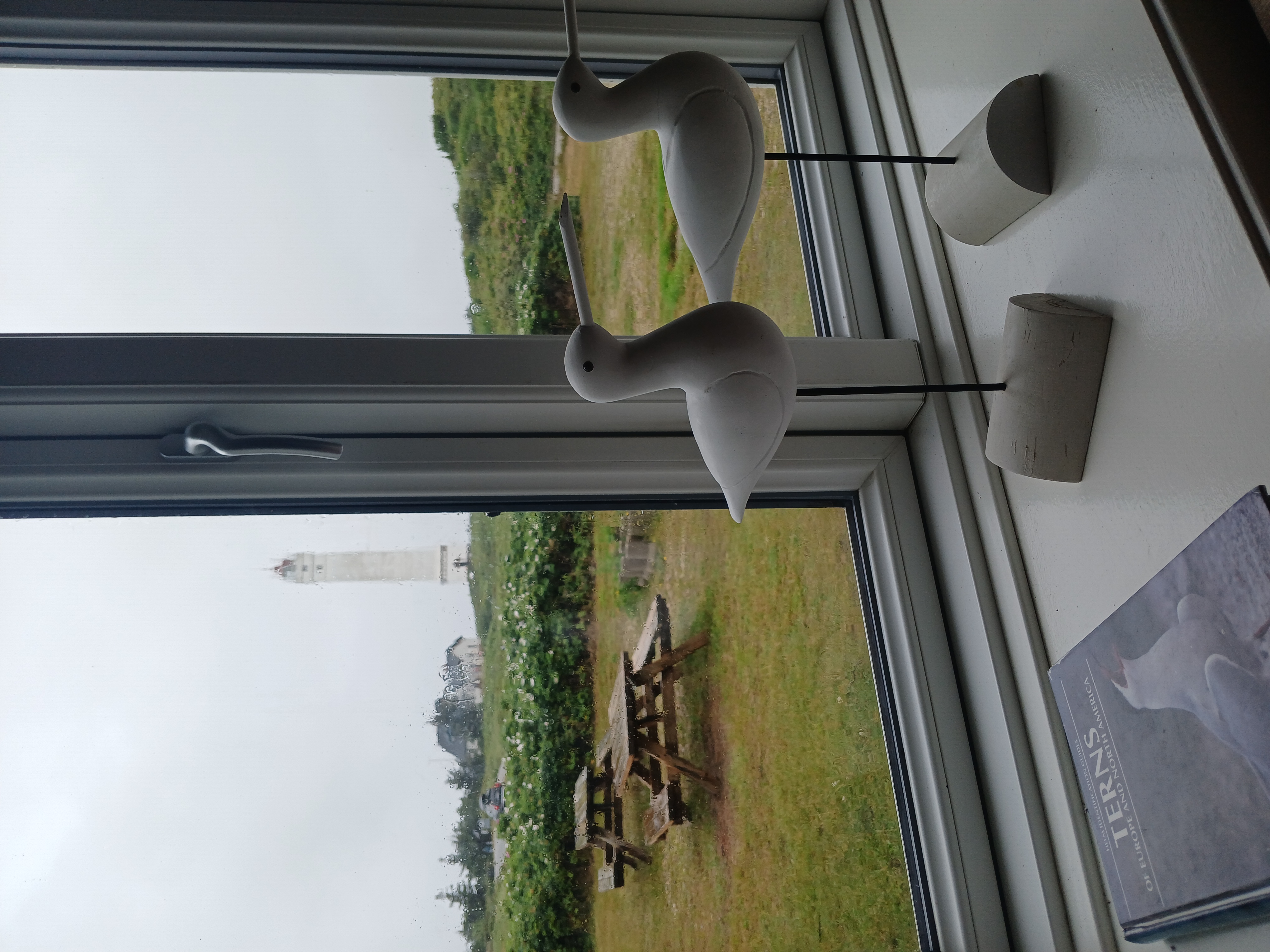
EC
Folk på stationen: Estelle Cumin, Freya Mørup-Petersen og Thomas Kristensen
Sådan en rigtig vadefugledag
Morgen observation:
Da jeg kørte mod Blåvand, tænkte jeg, at det helt sikkert ville tage et par timer, før observationen kunne gå i gang – det regnede lidt og lynede, hvilket var super ærgerligt, for forholdene så ellers rigtig gode ud i dag.
Men da jeg kom til Blåvand, viste det klassiske fænomen sig igen: Blåvand har sit helt eget vejr. Man kan aldrig regne med vejrudsigten herude. Selvom det var meget trykkende, holdt det sig tørt og så endda ud til at klare lidt op. Jeg gjorde mig klar og gik ud til obsen. Der kom stadig lyn i det fjerne, men jeg valgte at fortsætte og håbede, det ikke ville ende i et pludseligt skybrud.
Vinden var fra ØSØ, og allerede første gang jeg kørte skopet over vandet, blev jeg helt vildt glad – det væltede forbi med ryler og rødben! Forholdene var lidt svære, da det stadig var meget mørkt – morgenobsen startede kl. 5:00, og solopgang var først 5:14, så i det her vejr var der ikke meget lys at arbejde med.
Men det gik, og jeg havde bestemt sved på panden over alle de fugle, der skulle tælles og noteres. Det var derfor en kæmpe lettelse, da Henrik dukkede op efter bare 20 minutter. Lidt efter kom også David, og så var vi tre mand på obsen – og det var virkelig godt med dagens mange forskellige vader og andre arter. Det føltes næsten som et fuldtidsjob bare at holde styr på noterne!
I løbet af morgenen ændrede vinden sig pludseligt – med ét vindstød skiftede den fra ØSØ til SV. Det kunne mærkes: Det blev både køligere og mere blæsende på obsen, og nogle arter reagerede med det samme. For eksempel stoppede trækket af lille kobbersneppe næsten helt efter vindskiftet.
I løbet af obsen kom der 3.120 vadefugle trækkende forbi, fordelt som følger:
- 222 strandskader
- 36 strandhjejler
- 21 småspover
- 5 storspover
- 300 lille kobbersnepper
- 165 rødben
- 5 hvidklirer
- 27 stenvendere
- 333 islandske ryler
- 35 krumnæbbede ryler
- 17 sandløbere
- og sidst men ikke mindst 1.954 almindelige ryler.
Ud over det vilde vadefugletræk havde vi to sortterner rastende på stranden og en mega lækker 1k sorthovedet måge.
Det var en total vild dag for mig – især fordi det var første gang, jeg oplevede så heftigt et vadefugletræk. Flokkene kom næsten konstant, og det var en kæmpe oplevelse.
Lige nu ser det desværre ud til, at vinden går i NV i morgen – og med en del regn – så det er lidt ærgerligt. Men senere på ugen ser det lovende ud til nogen havfugle, og det glæder jeg mig meget til!
THK
Ringmærkning:
Dagen startede med, at Estelle og jeg tjekkede DMI's radar. Indtil i nat var der lovet masser af regn, hvilket ikke tegnede godt, men det meste kom lidt efter midnat og vi kunne se på radaren, at regnen lige gik uden om hukket - så det var bare om at komme i gang med ringmærkningen!
Luften var tung og fugtig, da vi åbnede net og det føltes næsten som at gå i et drivhus. Men fuglene var aktive, så det var i hver fald lovende. Dagen gik meget fint for sig med en god sjat fugle fordelt på flere arter, heriblandt to sortstrubede bynkefugle, som var gået i Helgolandsrusen.
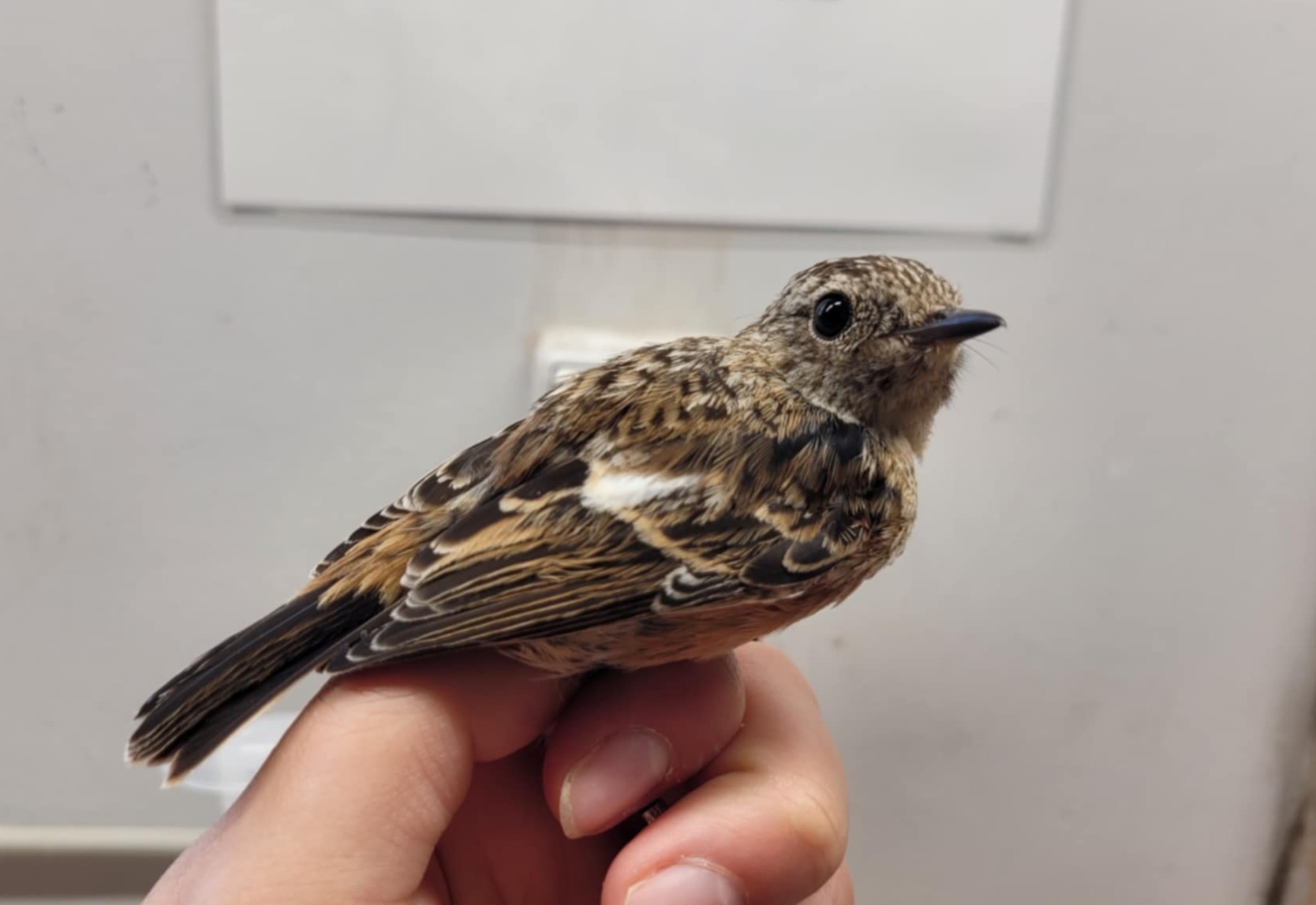
En ud af to 1k Sortstrubet Bynkefugl. Foto: Freya G. Mørup-Petersen
Da vi sluttede standard, var vi op på 20 ringmærkede fugle og 15 genfangster. Der var stadig fugle i krattene og vi havde lidt energi endnu, så vi lod stationshaven stå åben efter standard frem til klokken 18. Det gav lidt ekstra fugle, heriblandt en ufattelig fin Husrødstjert 2k+ han, som Estelle mærkede som sin første.
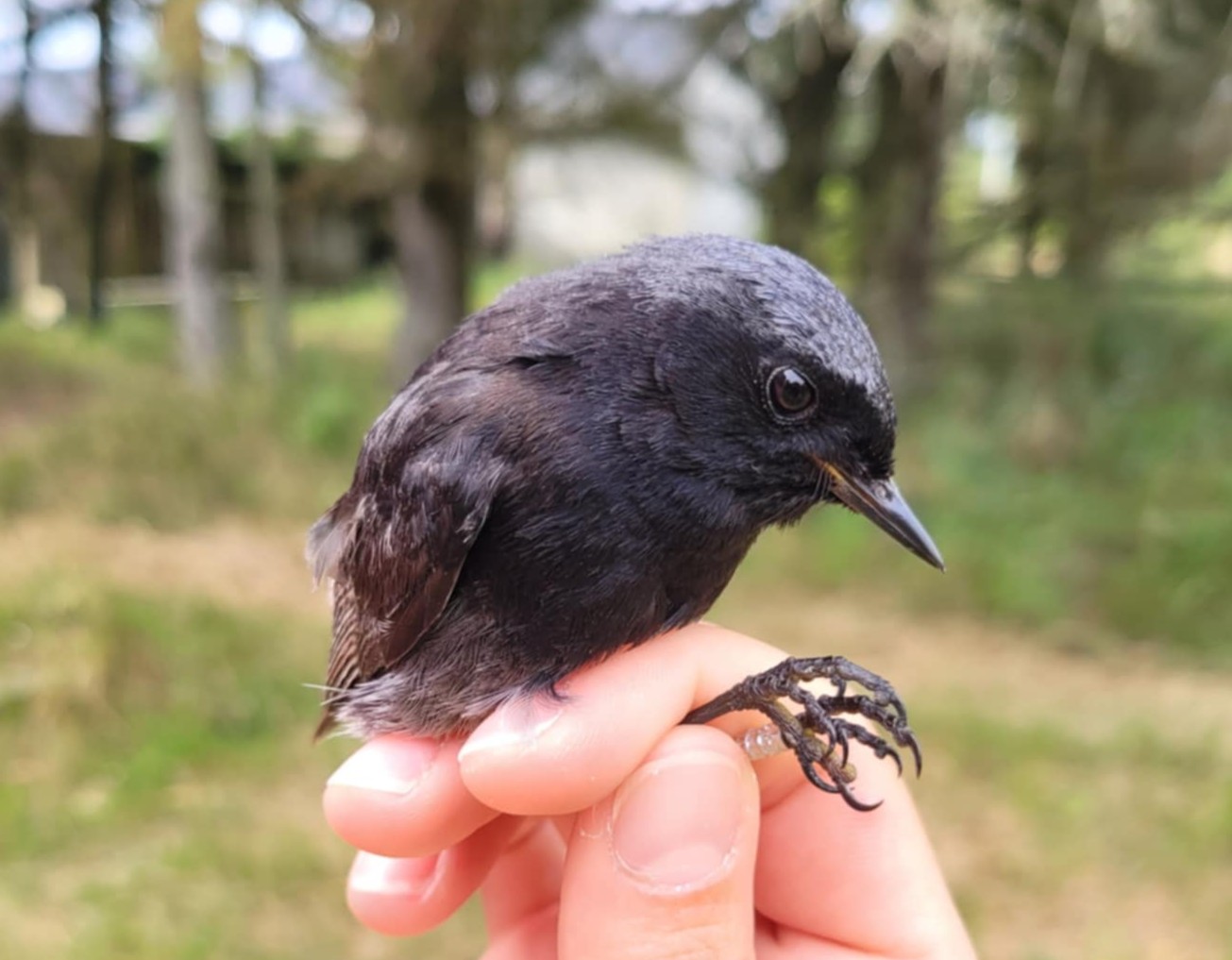
Husrødstjert er ikke en almindelig gæst i stationshaven. Denne her havde en fedtscore på 7 og en vægt på 20,0 gram, så den er nok på vej videre. Foto: Freya G. Mørup-Petersen
I morgen ser ikke alt for lovende ud i forhold til ringmærkning og det bliver spændende med al den regn der bliver varslet, om vi overhovedet kan komme til at mærke - men vejret er svært at forudsige herude, så det må vi se på i morgen tidligt.
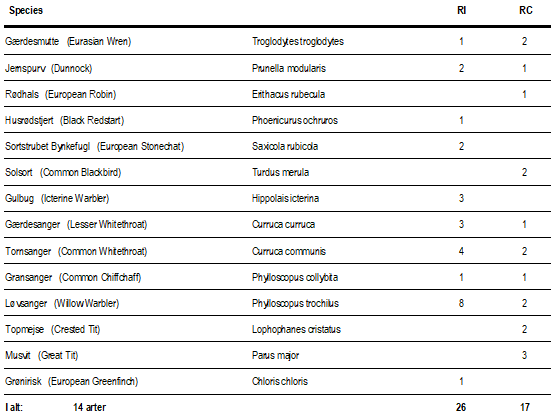
FGMP
Folk på stationen: David Manstrup, Henrik Böhmer, Estelle Cumin, Freya Mørup-Petersen og Thomas Kristensen
God diversitet og gode arter
Vejr kl. 5.00: Ø 6 m/s, 2/8, 19 grader, 30 km sigt.
Sådan! Klart vejr og østenvind i slut juli. Det er bare en fed opskrift på en god dag. David, Thomas (og far) og undertegnede startede alle på morgenobsen, da vi havde forventet en god dag med vadere. Selv om vejret var nogenlunde perfekt, kom der ikke så mange som vi havde forventet. Det startede godt med forskellige flokke af klirer, lidt ryler (bl.a. 9 krumnæbbede ryler i folk) og lidt spredte strandskader. Men det gik hurtigt i stå og vi måtte nøjes med ca. 700 vadere denne morgen. Det gik bedre med de rastende fugle, da der var kommet mange måger til, bl.a. over 600 sildemåger. Derudover en adult sorthovedet måge, en dværgmåge og en rovterne.
Lidt i 8 gik jeg tilbage for at åbne net i håb om at østenvinden havde bragt lidt nye fugle til området. Det var desværre også en lidt sløj omgang med 14 nye fugle på 5-6 timer. Diversiteten var god og med både stillits og ringdue i nettet, var det godkendt. Der var kommet lidt nye løvsangere til, alle adulte fugle.
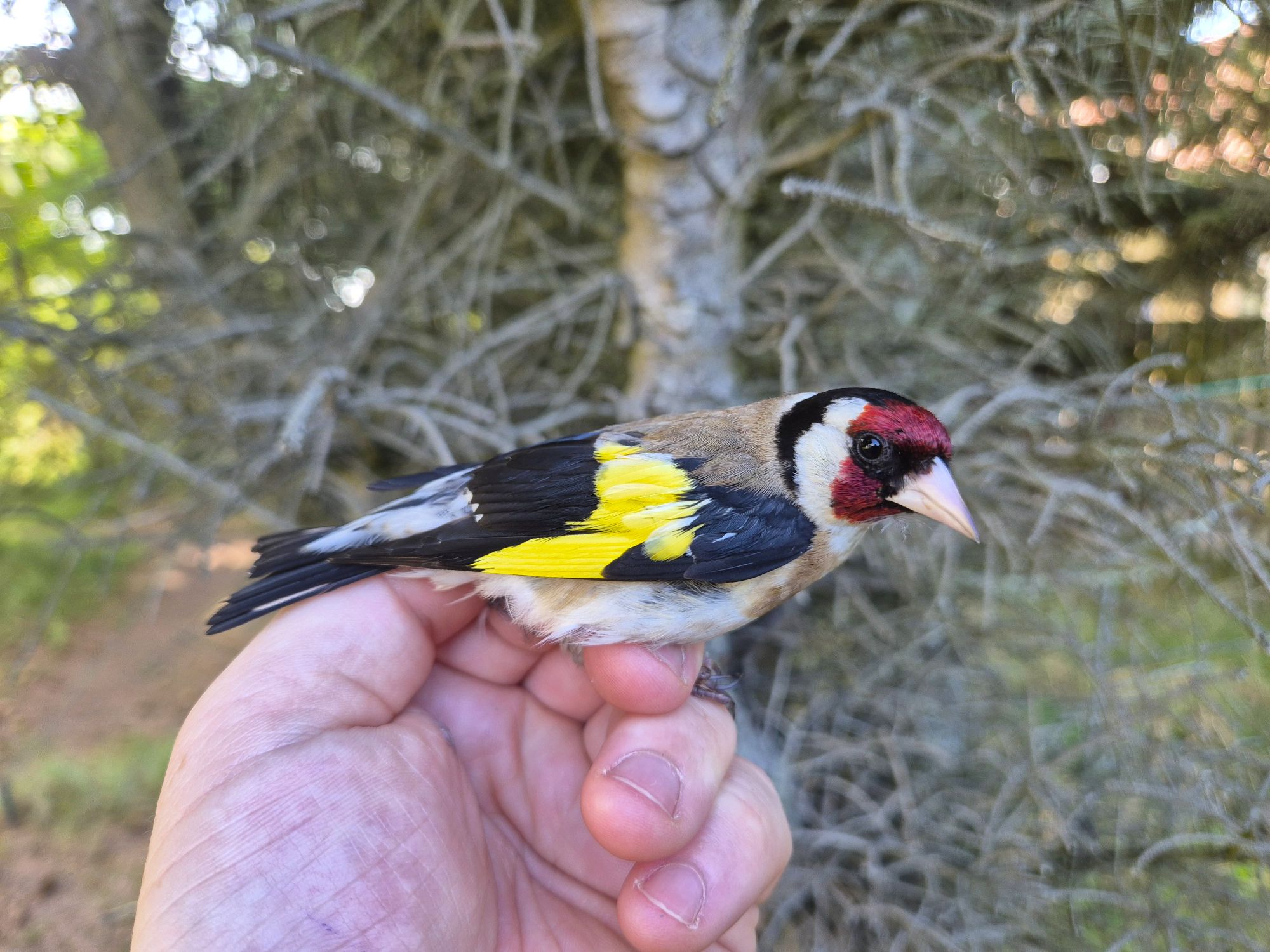
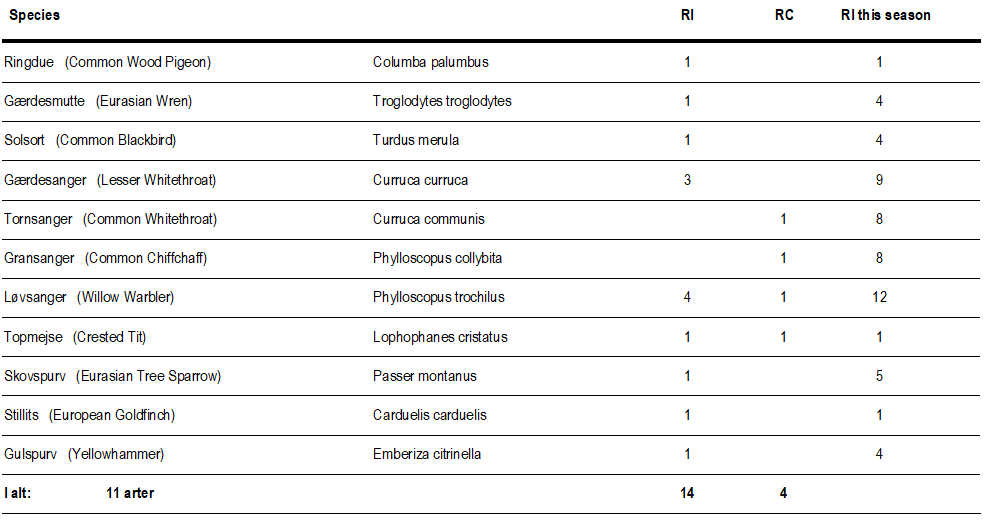
Imellem netrunderne hyggede vi i det dejlige vejr foran stationen og havde bl.a. en ung grønspætte der fløj lidt rundt. Den er ved at være årlig på hukket, men gik desværre ikke i nettet i dag.
Til eftermiddag ankom Freya og Estelle til stationen og er klar til at ringmærke i morgen.
Vejret i morgen ser spændende ud med regn i nat og vindskifte fra øst til sydvest. Havde det været i oktober, ville det være opskriften på et hit.
Træløber-dag
Vejr kl. 5.00: ØNØ 2 m/s, 8/8, +15 grader, 500 meter sigt
Igen i dag var hukket indhyllet i tåge. Det så egentlig fint ud fra solopgang, men det pakkede hurtigt til og toppen af fyret kunne nogle gange kun lige skimtes. Det var derfor igen svært at gennemføre morgenobsen. Thomas havde én fugl på 45 minutter og gav op.
Til gengæld var der lidt mere gang i ringmærkningen i dag. Fordi der var lidt mere aktivitet ved solopgang end i går, blev alle net åbnet og der var nye fugle på alle runder. Det blev til 24 nye fugle og 5 genfangster. Der var god diversitet og bl.a. med 6 tornsangere og 5 løvsangere virkede det til at der var kommet nye fugle til hukket. Dagens højdepunkter blev først en træløber og lidt senere en korttået træløber.
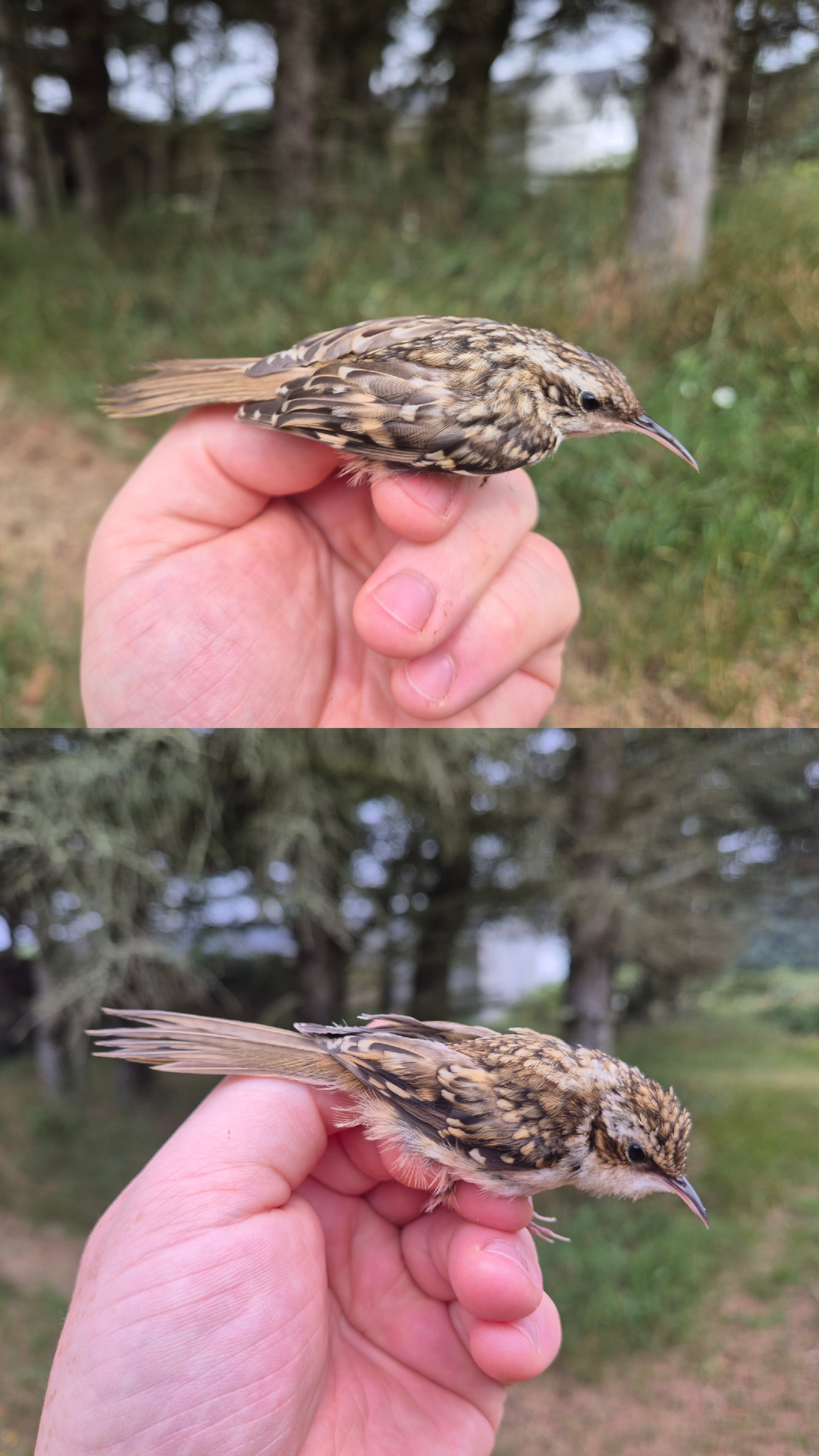
Øverst: korttået træløber. Nederst: træløber
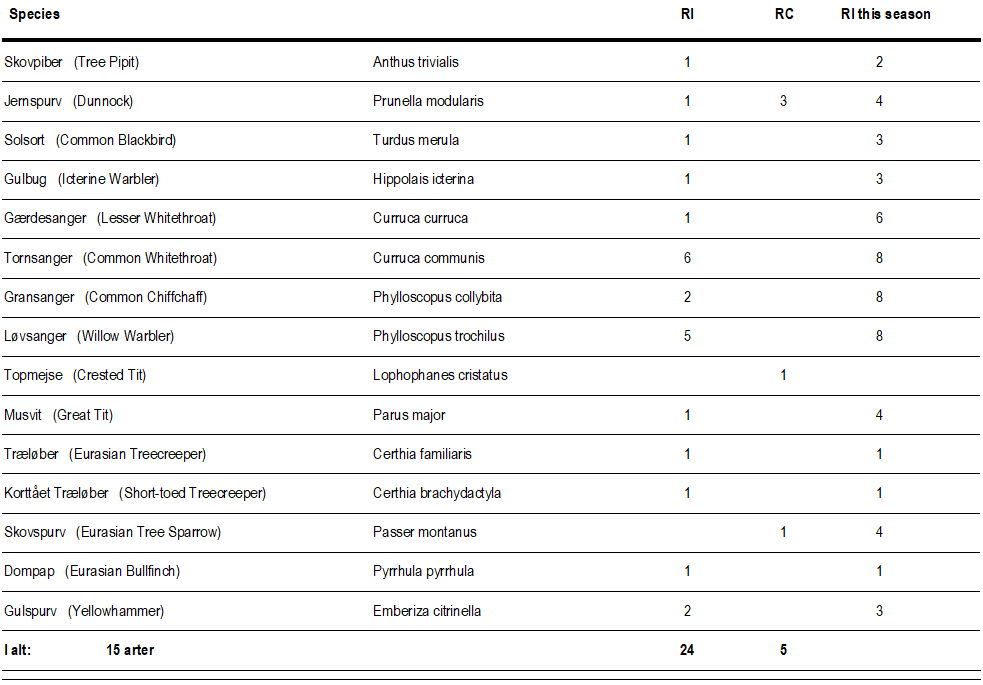
De sidste kanter og stier blev slået i dag, så nu står haverne bare skarpt til sæsonstart. Vi skal dog vente til mandag til Freya og Estelle er klar til den første rigtige sæsonstart. Freya er et kendt ansigt i vores ringmærkning og skal være her knapt en uge og Estelle er en fransk kvinde, der skal være her til d. 10. august.
Allerede i aften går vinden i øst og tager lidt til. Den forbliver i øst i ca. 1,5 døgn og med 5-6 m/s kunne i morgen og måske også mandag blive nogle gode dage med vadere. Vi glæder os også til at det igen klarer op på hukket.
Af andre observationer var det dejligt at se to hunner af hugorm lige omkring ringmærkningslab i fyrhaven.
